Shear Strength
‘Shear strength’ is the resistance offered by soil against shear deformation, its value is equal to the shear stress on critical plane (plane A-A). The critical plane is that plane on which resultant stress has maximum angle of obliquity with the normal of that plane.
Let,
σ1 is Major principal stress;
σ2 is Minor principal stress; and
θc is Angle of critical plane or failure plane
with the major principal plane.
- On the plane of θc (critical plane), σR is most inclined i.e., β = βmax. For frictional soils, βmax internal frictional angle of soil (φ).
- When angle β is maximum, then the shear stress on plane A-A will be equal to the shear strength of soil.
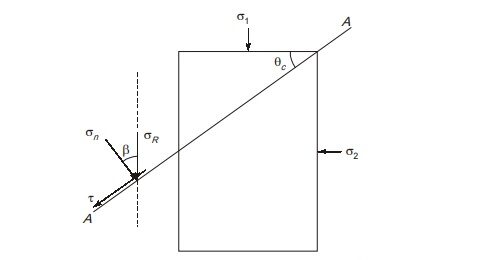
MOHR FAILURE CRITERION
- Mohr failure theory is based on the hypothesis that materials fails when the shear stress on the failure plane at failure plane reaches a value which is a unique function of the normal stress on the plane. i.e.,
τff = f(σff)
where, τ = shear stress and σ = normal stress; the first subscript refers to ‘failure plane’ and the second subscript denotes ’at failure’.
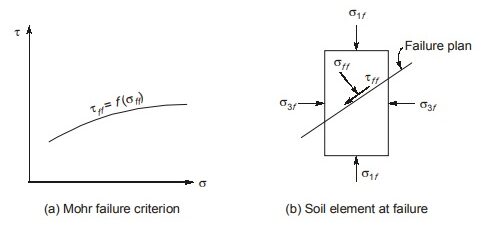
- From data of different tests we can have a series of Mohr’s circles. A line tangential to the Mohr circle gives a curve called Mohr failure envelope. It expresses the Functional Form of relationship between shear stress on failure plane at failure and normal stress on failure plane at failure.
- If Mohr circle lies below the failure envelope (circle-I), every plane passing through this point has a shearing stress which is smaller than the shearing strength; this is known as stable condition.
- Mohr circle lying above the envelope, (circle-II) cannot exist because it is not possible for the shear stress to exceed the shearing strength.
- Any Mohr circle whose tangent is the Mohr failure envelope, represents a condition where in the point of tangency gives the stress conditions on the failure plane at failure.
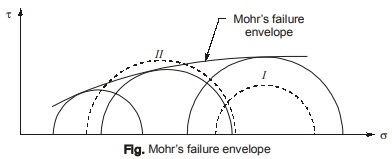
FACTORS AFFECTING SHEAR STRENGTH
Some of the factors affecting shear strength of soil are:
(a) Confining Stress:
(b) Drainage Conditions:
- It has been pointed out earlier that effective stress governs the shearing strength of soil.
![]()
- Drained condition occurs when the excess pore water pressure developed during loading of a soil dissipates i.e. ∆u = 0
- Undrained conditions occurs when the excess pore water pressure is not drained from the soil. i.e., ∆u ≠ 0.
- The existence of either condition–drained or undrained depends on the soil type, geological formation (fissures, sand layer in clays etc.), and the rate of loading.
- The values of shear strength parameters depends on the drainage conditions in saturated soils.
φ = φ′ in case of drained test
φ = 0 in case of an undrained test
(c) Density Index:
- The most important factor affecting the shear strength of granular soil is density index.
- For the same composition of the soil, higher the density, higher the angle of friction. Hence higher will be the shear strength.
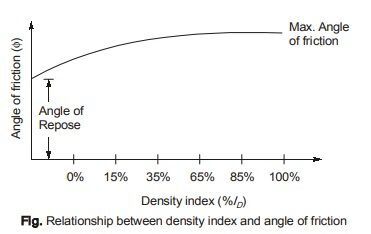
(d) Water Content and Saturation:
- In case of fine grained soils, cohesion between soil particles is inversely proportional to water content.
- The degree of saturation also affects the cohesion and the cohesion increases water content upto an optimum value above which it decreases with increasing water content for a given void ratio.
- On the other hand, in unsaturated soils negative excess pore water pressure increases the effective stress
(σ = σ – u). Thus, if the pore water pressure is negative, the effective stress increases.
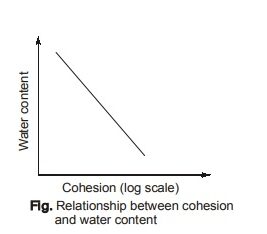
(e) Composition and Particle Characteristics:
- Angle of internal friction depends on grading of the soil. A well graded soil with high uniformity coefficient has a higher angle of friction as compared to poorly graded (i.e. uniform) soil.
- Similarly, sharp angular grains which can interlock well with adjacent grain will show higher friction angles. Hence, minerals such as mica and flaky particles will show low angles of internal friction.

